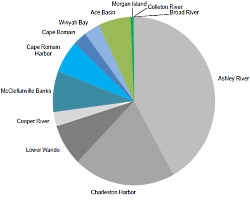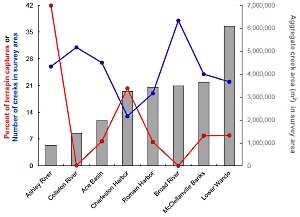Research - In-water capture rates
The Inshore Fisheries Research Section of the Marine Resources Research Institute has operated a monthly trammel net survey in most major South Carolina estuaries since 1990; however, the two southernmost estuaries are only sampled four (vs. 12) times each year and have also only been sampled since 2000.

The trammel net survey is conducted in large water bodies that enables the rapid deployment of a 600' mesh net along the edge of the marsh during an ebbing tide. Since 1995, diamondback terrapin capture rates in each randomly selected net set have been recorded. Accordingly, this trammel net survey provides the most spatially comprehensive and standardized data set for monitoring in-water diamondback terrapin relative abundance trends in South Carolina.
Through 2013, diamondback terrapins (20,557) were the fifth most common organism in the trammel net survey15. Seventy-two percent of terrapin captures occurred in four sampling areas near Charleston, SC (gray shade)16. Twenty percent of all diamondback terrapin captures occurred north of Charleston (blue shade) between McClellanville and Winyah Bay, and the final 7% captured south of Charleston (green shade), mostly in the ACE Basin16.

Analysis of diamondback terrapin capture rates reveals a high degree of consistency in monthly catch rates among estuaries, with peak monthly catch in April followed by a systematic (and generally smooth) decline through December15. In contrast, inter-annual trends in catch rates between 1995 and 2013 were not consistent among estuaries. In the Ashley River, where 42% of all diamondback terrapin captures occurred, catch rates were generally stable15. A slight increase in catch rates in Winyah Bay (3% of all captures) was noted between 2003 and 2013; however, most estuaries (and thus the statewide average) reflect a general decline through 201315.
When exceptionally high catch rates in the Ashley River15 are disregarded, much of the variation in diamondback terrapin catch rates across South Carolina estuaries appears to be explained tidal creek abundance (but not area) present in the trammel net survey area. More specifically, trammel net survey areas with fewest tidal creeks are associated with the greatest overall number of terrapin captures and vice-versa. We interpret this observation to reflect greater time spent in river-edge habitats sampled by the trammel net survey where tidal creeks are not as abundant.

